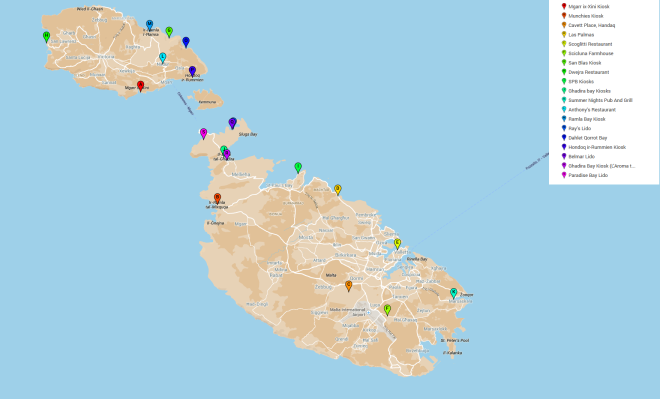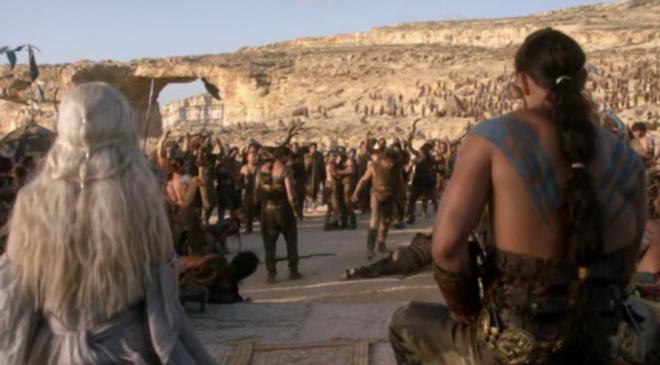There is nothing better in this world than an ice cold beer on a scorching Maltese beach in Summer. As temperatures have started soaring in Malta, people have begun to flock to the coast and splashing their Facebook walls with their ‘First Swim Selfies’. With the tourism sector gearing up for a busy 2015 summer period, I have decided to also do my part by providing tourists and local revellers with a guide to illegally and abusively constructed eating outlets around Malta and Gozo.
Before we kick this off, let me clarify what I mean by ‘illegal’ and ‘eating outlet’. By referring to an outlet as being illegal, the outlet may be constructed without a permit in its entirety, or it may have some form of illegal extension to the legal part of its premises. There are also a couple of outlets that may be legal but are still abusively occupying public space. In any case, the majority og these outlets are breaking the law and occupying public land, and in most cases even constructing parts of their premises in ecologically sensitive areas. An eating outlet may range from a full fledged restaurant, to a beach lido, to a kiosk, to a make shift outlet that cooks on a barbecue (this is actually true).
A – Mgarr ix-Xini Kiosk – This outlet been in breach of a MEPA enforcement notice since 2007, and is labelled as “pending direct action”. Tens of thousands of euros were be paid out to this ‘business’ as it was forced to close because of the ‘blockbuster’ movie By the Sea that was shot at Gozo’s Mgarr ix-Xini by Brad Pitt and Angelina Jolie. Source: The Malta Independent. On a separate note, I had visited this outlet once and was not even provided with a VAT receipt. Therefore this outlet is illegally occupying land and does not even pay VAT on all income generated.

Brad and Angelina were filming By the Sea in Malta in the summer of 2014 in Mgarr ix-Xini. The area was cordoned off to keep out the peasants, so business were compensated. One of these happen to be this illegally built restaurant. The seafood os good though, albeit a bit pricey. (Photo credit: Us Magazine)
B – Munchies Kiosk (Golden Bay) – An honourable mention since this has now been (finally) demolished – The kiosk used to occupy an ecologically sensitive area and has been dismantled. Although most of the new facility will be located under the car park, the new development will include an 80 square metre terrace overlooking the beach. Source: MaltaToday

The proposed new Munchies restaurant. After years of illegally occupying ecologically sensitive area, the owner gets off easy with a newly approved location in the same beach (Photo credit: MaltaToday)
C – Cavett Place/Tac-Cavett – The site includes structures without a permit, and the enforcement notice also states the use of the site was switched from a farm to a venue hosting commercial activities that include serving food and drinks. Source – Times of Malta
D – Las Palmas (Bahar ic-Caghaq) – Served with an enforcement notice in May 2014 after a metal railing structure to serve as a raised platform for tables, chairs and umbrellas was erected. By November 2014, number of covers doubled despite an enforcement notice served by Mepa last May. Source: Times of Malta
E – Scoglitti Restaurant (Valletta) – In February 2015, MEPA issued a number of enforcement notices over the erection of a boundary wall and lampposts and a number of alterations to the façade without a permit. Source – MaltaToday.

The illegal extension of Scoglitti Restaurant is denying access to the public, mainly fishermen and canoeists. but even Posh people need to eat right? (Photo credit: MaltaToday)
F – Scicluna Farmhouse (Gudja) – A Gudja farmhouse was illegally converted into a restaurant. Despite complaints by its neighbours, it continues to operate despite having been slapped with an enforcement notice by the planning authority in 2012. Source: Times of Malta
G – San Blas Kiosk – In 2009 MEPA issued an enforcement notice against a ‘structure’ serving as a kiosk for the hiring of deckchairs and umbrellas. In 2010 MEPA issued an enforcement notice against a bamboo enclosure (in which bricks were being kept) and the construction of stairs leading to the beach. Burgers are still being served today. Source – MaltaToday, The Malta Independent
H – Dwejra Restaurant (Gozo) – Not an illegal case, but a highly abusive one. A restaurant was never meant to be built in Dwejra, but this was controversially incorporated into the Interpretation centre in 2007. A permit for a permanent generator in the middle of the existing car park at this site was filed in 2013. Source: MaltaToday

The restaurant owner has been vying for an outlet in this area for nearly two decades. His wish came through when he negotiated to have this outlet incorporated into the Interpretation Centre in Dwejra. If only we could do something about that horrid font and colour, naqa cliché hux? (Photo credit: MaltaToday)
I – Kiosks in St Paul’s Bay – llegal works were being carried out along Qawra Promenade to enable the relocation of three Kiosks that are occupying land needed for the development of a Private Aquarium in the area better known as Ta’ Fra Ben. Source: Malta Star
J – Ghadira Bay Kiosks – Another legal case but executed to high degree of stupidity. Concrete bases were laid down in the bay, impacting the coast, the sand dunes and surrounding ecology in this Natura2000 site. The permit for the kiosk had been repeatedly refused, and one of the kiosk had two enforcement orders, which were swept away by the approved Development Notification Order. This DNO system bypasses public consultation to fast-track applications for minor works. Source: Times of Malta
K – Summer Nights (Marsascala) – Since 2001, the owner has not applied for a permit allowing him to cook food on site. Source: Times of Malta.
L – Anthony’s Restaurant (Nadur) – This case has been regulated, but harmful impacts to the traffic flow of the area still persist. Outlet owner has a permit to place a small number of tables, and last April (2014), it applied for a permit to “extend pavement under the area covered with the concession for placing of tables. No permit was issued to extend the area in which tables and chairs were placed, but this did not appear to deter the restaurant, which ended up incurring an enforcement notice for occupying a larger public space than it was allowed to. Eventually, however, the restaurant relented, and the offending street furniture was removed. Source: The Malta Independent
M – Ramla Bay Kiosk – An enforcement order was also issued in 2012 against a kiosk built without a permit on scheduled land in Ramla l-Hamra in Gozo. An application to sanction the kiosk presented by the owner in 2009 was withdrawn by the Planning Directorate. Source – MaltaToday

This illegal kiosk refuses to enter the 21st Century, with its tacky and cheap design and finishes. But what is the point of spending money when there is no competition in the area? (Photo credit: BeachMalta)
N – Ray’s Lido (Armier) – Enforcement order issued in 2003, referring to the illegal development of a two-storey building and to two concrete platforms in the sea. An appeal against the enforcement order was rejected in 2006. In parallel to this appeal the owners also presented three applications to regularise the development, the latest of which was turned down in 2009. Subsequently the owner applied for a reconsideration of this decision, which was turned down twice in 2011. But an appeal against this decision is still pending. Source – MaltaToday
O – Dahlet Qorrot Kiosk – Similarly, an enforcement against a kiosk in Dahlet Qorrot, an area of ecological importance in Qala, has been pending for the past 10 years. Source – MaltaToday
P – Hondoq ir-Rummien Kiosk – A kiosk in Hondoq ir-Rummien is also subject to an enforcement order issued by MEPA in 2000. Applications to regularise the kiosk and allow tables to be placed outside it was rejected in 1998 and 2000. Source – MaltaToday
Q – Belmar Lido (Armier) – An enforcement order against the Belmar lido was issued in 2006. The enforcement notice refers to the change of use of part of the beach into a private lido. An appeal was presented against the enforcement order but this was rejected three years later. Source – MaltaToday
R – L’Aroma Terrace (Ghadira Bay) – An enforcement order against the development of a concrete platform, wooden canopy, stairs and concrete ramp without permit was issued against the Adira lido in 2010. The enforcement has been pending for the past four years. No attempt has been made to regularise this development through a formal application. Source – MaltaToday

This outlet in Ghadira wants you to enjoy its products in a safe and accessible environment, so it went the extra mile by building a concrete platform illegally in the beach. (Photo credit: MaltaToday)
S – Paradise Bay Lido – served with an enforcement order against the construction of an illegal canopy covering the restaurant’s terrace, the construction of a room being used as a kitchen and the creation of concrete paved areas used for the placing of sunbeds and umbrellas. A similar enforcement notice against concrete paving in the same site was issued in 1993. According to MEPA’s files this case is still, 20 years later, awaiting “direct action”. Source – MaltaToday
* * *
The above outlets are only the ones reported by the media, and represent merely a fraction of all the eateries in Malta that have illegalities that are simply swept under the rug. Furthermore, if one takes into the account all the sun bed and umbrella renting outlets, mobile kiosks, and other merchants operating in coastal areas without the necessary permits, the above map would become too congested.
With tourism figures growing each year, these outlets will ultimately increase in number and end up occupying more public space and damaging sensitive ecological areas. Ironic how the government wants to build more hotels to improve the tourism sector, when the sector currently requires so much more enforcement.
At least we can rest easy knowing that the Tourism Minister publicly came out against illegal restaurants and kiosk operating in coastal areas. This was in July 2014, so may be this post will help the minister and the pertinent authorities start enforcing these outlets. Come on guys, this is just like going to the gym – the first few days are the hardest!
Whatever you do this summer, eat responsibly and support your law abiding restaurateurs!










